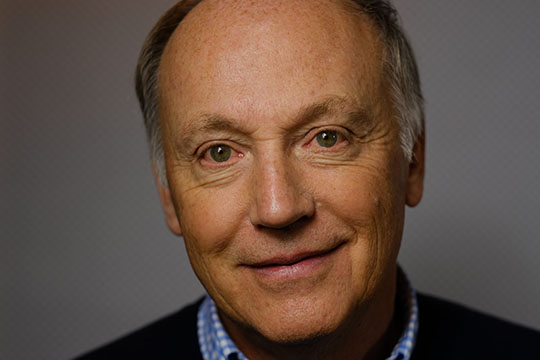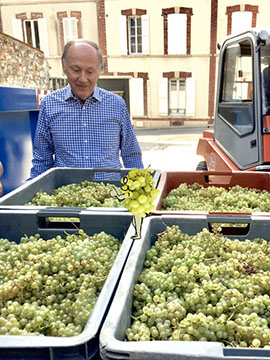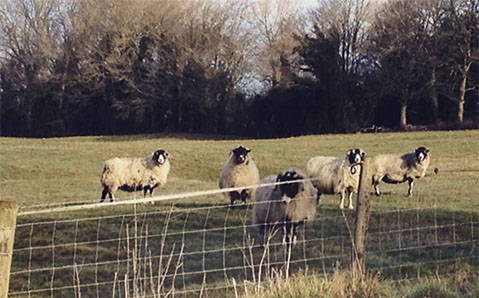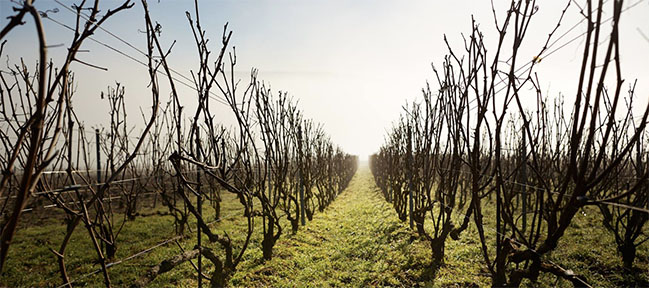
Champagne as a winemaking region has been mostly late to the party when it comes to organic viticulture. However a small group of wineries are leading the way, showing that exceptional Champagnes can be made successfully using biodynamic and organic practices.
Leclerc Briant, founded in 1872, is one of only 40 Champagne houses that employs biodynamic practices. The estate has been organic for three generations and is biodynamically certified since the 1980s. They also have creative streak as shown in an underwater aging project called the Abyss. Champagne is aged for 15 months underwater at a depth of 60 meters at the Bay of Stiff on the eastern tip of the Île d'Ouessant, off the coast of Brittany.
Grape Collective talks with Leclerc Briant's winemaker and biodynamic apostle Hervé Jestin about the trend towards organic production in Champagne.
 Christopher Barnes: Hervé, talk a little bit about the history of Leclerc Briant.
Christopher Barnes: Hervé, talk a little bit about the history of Leclerc Briant.
Hervé Jestin: Champagne Leclerc Briant is a very old company located in Epernay. And the company was created a very long time ago but unfortunately when Pascal, the former owner, passed in 2010, the four daughters decided to try to continue the activity but it was too difficult. Reason being because in France when you have to finance the succession fee it's impossible. So they decided to sell the company to Roederer. And we bought the company from Roederer and in 2012 we bought a new vineyard. We bought 14 different hectares of vineyard located in different parts of Champagne but one of the key points of this story is that they are all biodynamic.
Yes yes. Pascal Leclerc, the former owner, was one of the pioneers of biodynamics in Champagne. He started to work with biodynamics in 1991. In that time there were two people working on biodynamics in Champagne. And what we do, what we decided to do, we decided to create a sort of winemaking, the continuation of the biodynamic vine growing.
We decided to work on the biodynamic winemaking which is in existence in the world. You can't find many books on the subject. On the vine growing, yes. But you can't find any books on the winemaking, on the biodynamic winemaking. So I starting to work on the subject when I was Chef de Cave for a big name. I was working for a big name from '82 to 2006 and we decided to continue and to create a larger range of wine made with the biodynamic approach.
Hervé talk a little bit about your background as a winemaker.
So I studied at the University of France, the University of Dijon, the University of Bordeaux, and the University of Paris you know. And I spent 24 years working as Chef de Cave at Champagne Duval-Leroy. And I decided to leave in 2006 to become a sort of independent consultant. So I worked in many places in Europe. I worked in Italy and Spain and England, in Russia, in Crimea and of course a lot in Champagne. Working in England, that's kind of fun. With global warming I understand that they're close to where Champagne was in the '70s in terms of climate.
Working in England, that's kind of fun. With global warming I understand that they're close to where Champagne was in the '70s in terms of climate.
Yes more or less. The situation now is not always like that, not every year under control, because of the humidity there. The climate could be very difficult for the vineyard and could have some difficulties during the flower season because of humidity. But more or less we are able to produce between five and six thousand bottles per hectare. And the quality is more or less okay. We have the conditions we had in the '70s, in the '80s in Champagne so it's okay. But what we have to work on is the depth of the wine, because today it's a bit short so it's a point on which we have to work for the future.
Hervé talk a little bit about biodynamics. It's very unusual to see biodynamics being applied in the Champagne region.
Yes, it's difficult in Champagne to be honest because the climate is difficult. The average size of the plot is very small and maybe the average size is .25 hectare. So it means we have to be very careful when your neighbor is a conventional neighbor. We have to separate the row closest to your neighbor and you have to make a sort of different winemaking. But the problem is the climate. We have a huge issue with mildew and this is the main difficulty. In 2012 we have had a huge problem with mildew and we lost 50% of our production so it's very difficult to manage.
Now we work more and more on new experimentations to avoid the use of copper and to be able to care for mildew. Because mildew is not a problem. It is only a problem because it attacks the grapes but the question is why is the mildew there? So in biodynamics we don't want to fight it. We want to understand why this mushroom is there. Because it's not its living place. The mildew has nothing to do in the vineyard. So maybe if the mildew is there it's because we are doing something wrong, you know?
So the idea is to understand why the mildew is there. And biodynamics is a sort of global system to manage the vineyard. We work with a living system and not with a dead system and with the living system the idea is just to bring natural information so that it's not our responsibility to care for the vineyard. It's the responsibility of nature to care for the vineyard. So the idea is to bring the right information to the vine, to the soil, and that's all. But it takes a long time to be able to manage the system. And what are some of the tools that you use in biodynamics instead of conventional sprays?
And what are some of the tools that you use in biodynamics instead of conventional sprays?
The idea is to bring a sort of life in the soil. This is the first thing, so we use different preparations and for the soil we use mainly what we call the 500P and manure. These are the preparations we use. And the second preparation we use, but later in the season, is the silica. The idea is to work with flower preparation, flower decoction, plant deduction, minerals, to bring the information that nature needs to improve and to care for itself. It's a system which takes into consideration the influence of the planets, the moon of course, matching the different constellations so in function with the position of the sun, the moon, the different constellations. We know if we have a risk in terms of disease and so we manage and we try to anticipate. So we never use any chemicals or pesticides. We only use natural substances.
The only problem with biodynamics today is the use of copper. So now the level of copper we use at Leclerc Briant is more or less between two and three kg per hectare per year. And the maximum is six kg. The idea is to limit the use of copper to be under one km for the moment but I expect that in four or five years we will be able to avoid copper.
And how many wineries are working with biodynamics in Champagne at the moment?
The number of biodynamic producers is very limited. We are fewer than 40 growers in Champagne so the area is very small here. We have fewer than 200 hectares.
And then in terms of organics?
Organics is three times more. It's 600 hectares. Which is still pretty small.
Which is still pretty small.
Yes yes. Because the total area in Champagne is 35,000, so the area is limited.
And do you feel that it's something that more and more people are paying attention to now?
Yes of course the consumer now pays attention to what they eat, to what they drink, so our responsibility is just to be able to produce wine that will bring positive things to the consumers. When you open a bottle of Champagne it's always to celebrate something nice. We don't want to produce wine with pesticides. When you celebrate the birth of a small baby you know it's a joke to use pesticides because we are behind all the nice moments of humanity. So it's okay, it's our target is to produce wine in Champagne that will bring very positive things for the people. And for that we decrease the level of sugar. All our range is less than five g per liter of sugar and half of our production of Champagne has no sugar added. So we limit the quantity of sulfites, we have two cuvées without any sulfites. So biodynamics permit us to manage those technical difficulties.
And are the yields the same with conventional and biodynamics?
The yield could be lower but in 10 years there's not a huge difference. Sometimes, as in 2012 when we have a huge problem with mildew, the yield is half but in a normal year we make 10% less than the conventional. This year we have got 11.5 tons per hectare so it was okay.
The yield is one thing but the idea is to work on the quality and we know that the yield could be lower, but it's a choice. It's a personal choice. And what we try to do in the winemaking you know, we take into consideration the influence of different parameters. For instance the first fermentation, the alcoholic fermentation is under control of the moon and the sun activity. And this year we have got a problem in Europe in general because the planet Mars was very close to the earth, the distance was 75 million km this year. And the normal distance is between 300 and 400 million km. So the planet Mars is in connection with the bacterium. When the planet Mars is close to half the distance it decreased...it sent a signal to the bacterium and we have seen some fermentation, some alcoholic fermentation stopping with residual sugar. We have noticed the beginning of the malolactic fermentation on residual sugar because of this proximity of the planet Mars. So it's an example of what we have to think about with this approach to the winemaking. And you're writing a book about biodynamics in the winemaking process.
And you're writing a book about biodynamics in the winemaking process.
We all consider when the grapes are harvested that the process is finished. For us the process has started. And our departure point is the harvest and for some people the last point is harvest. It's very French you know. Because it takes four months between the flowering and the harvest. But if you age 10 months or sometimes more, your wine, it takes 10 months. Four months? Ten months? You consider there is a huge influence of different parameters on the vine growing and no influencers on the winemaking during 10 months. So we had to discover everything because it's impossible to find any book on the subject. And Steiner didn't write a lot on winemaking. On the vine growing there are not many articles, and on the winemaking nothing. So I spent 25 years on the subject and now it's true that I'm ready to write a book on the subject.
I don't know if I will write it because it's a hard job and the situation changes every day. What was a mistake 10 years ago is okay today and we never know what the future will be so you know, if you write a book the book could be a sort of legend book in three or four years. The people will follow your book. Steiner tells you this, Steiner was living one century ago. So a part of what was written is okay but a part is not adapted to this period of humanity.  And talk a little bit about some of the different wines that you make currently.
And talk a little bit about some of the different wines that you make currently.
Yes so at Leclerc Briant we produce 14 different cuvées. Some single vineyard. And we produce two different Chardonnays coming from two different single vineyards we hold. We produce one Blanc de Noir from the Hautvillers, the single vineyard is located just under the Abbey of Hautvillers and we produce a single vineyard coming from Le Mesnil-sur-Oger, pure Chardonnay, Grand Cru. And another one coming from Vertus, Premier Cru. We produce two different rosés, an assemblage and a skin contact which is a vintage. We produce of course a reserve. We produce a pure Cramant. Pure Grand Cru from Cramant without anything. Without any sulfites, dosage.
One thing also is very interesting. We left some bottles aging under the sea at 60 meters deep just close to the bottom and we let the barrel aging around 15 months at 60 meters deep without any oxygen, with the same pressure inside. The interesting thing is the energy in this place because you have a permanent water dynamization which means that the energy in the bottle is 30% more than the same bottle aging in our cellar. We make plenty of experiments. We also use the sort of stainless steel barrel with gold inside to increase the influence of the solar activity on the first fermentation. And for the range we also produce a vintage. Today it's a 2009. We produce a demi-sec. A vintage demi-sec 2009 so we have plenty of different very nice products adapted to every sort of consumption.
 So let's talk a little bit about the grower Champagne movement. It's something that in New York has been a very visible movement. In the rest of the world it's starting to take off now where people are thinking about Champagne in terms of the terroir, in terms of the winemakers, how do you see that?
So let's talk a little bit about the grower Champagne movement. It's something that in New York has been a very visible movement. In the rest of the world it's starting to take off now where people are thinking about Champagne in terms of the terroir, in terms of the winemakers, how do you see that?
I think that now in the world people pay attention to what they eat, to what they drink. They want to know who is producing what they eat or what they drink. In Europe, in France, in England, in Germany, in Japan everywhere the people want to know who is responsible for what they eat and what they drink. So the demand for authentic wine is more and more important and the demand for real natural production is more and more important. The people don't want to continue to drink a sort of industrial wine even if those wines are good. It's not the problem because a lot of industrial wines are good. So they want an additional dimension. I think that industrial wines are good on the horizontal dimension but there is a demand for a sort of vertical dimension. The consumer wants to find a sort of emotion when they taste the wine more and more. The consumption decreases but the quality increases and the resurgence of authentic wine increased a lot everywhere.
Leclerc Briant has been in this direction for a very long time because we were among the pioneers in this direction. So this is the reason why the success is there today. We try to be very clear, very transparent when we make our production, when we explain what we do. So the people like this approach and so I think we are in the right direction and we will increase our knowledge on the nature rules and so it's our life.














